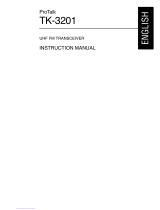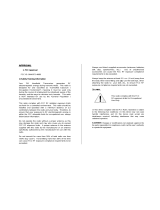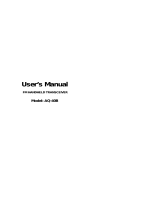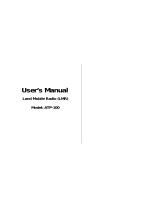
© B62-1760-00 (E)
09 08 07 06 05 04 03 02 01 00
TK-2180/ TK-3180
VHF FM TRANSCEIVER/
UHF FM TRANSCEIVER
INSTRUCTION MANUAL
ÉMETTEUR-RÉCEPTEUR FM VHF/
ÉMETTEUR-RÉCEPTEUR FM UHF
MODE D’EMPLOI
TRANSCEPTOR DE FM VHF/
TRANSCEPTOR DE FM UHF
MANUAL DE INSTRUCCIONES
RICETRASMETTITORE FM VHF/
RICETRASMETTITORE FM UHF
MANUALE DI ISTRUZIONI
VHF-FM-TRANSCEIVER/
UHF-FM-TRANSCEIVER
BEDIENUNGSANLEITUNG
VHF FM ZENDONTVANGER/
UHF FM ZENDONTVANGER
GEBRUIKSAANWIJZING

VHF FM TRANSCEIVER/
UHF FM TRANSCEIVER
TK-2180/ TK-3180
INSTRUCTION MANUAL
ENGLISH

THANK YOU
We are grateful you chose KENWOOD for your land mobile radio
applications. We believe this easy-to-use transceiver will provide
dependable communications to keep personnel operating at peak
efficiency.
KENWOOD transceivers incorporate the latest in advanced
technology. As a result, we feel strongly that you will be pleased
with the quality and features of this product.
MODELS COVERED BY THIS MANUAL
• TK-2180: VHF FM Transceiver
• TK-3180: UHF FM Transceiver
NOTICES TO THE USER
◆ Government law prohibits the operation of unlicensed radio
transmitters within the territories under government control.
◆ Illegal operation is punishable by fine and/or imprisonment.
◆ Refer service to qualified technicians only.
SAFETY: It is important that the operator is aware of and
understands hazards common to the operation of any transceiver.

i
PRECAUTIONS
• Do not charge the transceiver and battery pack when they are
wet.
• Ensure that there are no metallic items located between the
transceiver and the battery pack.
• Do not use options not specified by KENWOOD.
• If the die-cast chassis or other transceiver part is damaged, do
not touch the damaged parts.
• If a headset or headphone is connected to the transceiver, reduce
the transceiver volume. Pay attention to the volume level when
turning the squelch off.
• Do not place the microphone cable around your neck while near
machinery that may catch the cable.
• Do not place the transceiver on unstable surfaces.
• Ensure that the end of the antenna does not touch your eyes.
• When the transceiver is used for transmission for many hours, the
radiator and chassis will become hot. Do not touch these
locations when replacing the battery pack.
• Do not immerse the transceiver in water.

ii
Turn the transceiver power off in the following locations:
• In explosive atmospheres (inflammable gas, dust particles,
metallic powders, grain powders, etc.).
• While taking on fuel or while parked at gasoline service stations.
• Near explosives or blasting sites.
• In aircrafts.
• In medical institutions or near persons using pacemakers.
• Do not disassemble or modify the transceiver for any reason.
• Do not place the transceiver on or near airbag equipment while
the vehicle is running. When the airbag inflates, the transceiver
may be ejected and strike the driver or passengers.
• Do not transmit while touching the antenna terminal or if any
metallic parts are exposed from the antenna covering.
Transmitting at such a time may result in a high-frequency burn.
• If an abnormal odor or smoke is detected coming from the
transceiver, switch the transceiver power off immediately, remove
the battery pack from the transceiver, and contact your
KENWOOD dealer.
• Use of the transceiver while you are driving may be against traffic
laws. Please check and observe the vehicle regulations in your
area.
• Do not expose the transceiver to extremely hot or cold
conditions.

iii
CONTENTS
UNPACKING AND CHECKING EQUIPMENT ............................. 1
S
UPPLIED ACCESSORIES ....................................................... 1
PREPARATION .............................................................. 2
B
ATTERY PACK PRECAUTIONS .................................................. 2
I
NSTALLING/ REMOVING THE (OPTIONAL) BATTERY PACK ......................... 7
I
NSTALLING THE (OPTIONAL) ANTENNA .......................................... 8
I
NSTALLING THE BELT CLIP .................................................... 8
I
NSTALLING THE CAP OVER THE UNIVERSAL CONNECTOR .......................... 9
I
NSTALLING THE (OPTIONAL) SPEAKER/ MICROPHONE OR HEADSET ............... 9
GETTING ACQUAINTED .................................................. 10
D
ISPLAY ................................................................... 12
PROGRAMMABLE FUNCTIONS ......................................... 14
BASIC OPERATIONS ..................................................... 16
O
VERVIEW ................................................................. 16
S
WITCHING POWER ON/ OFF ............................................... 16
A
DJUSTING THE VOLUME .................................................... 17
S
ELECTING A ZONE AND CHANNEL ............................................ 17
T
RANSMITTING .............................................................. 18
R
ECEIVING ................................................................. 18
CONVENTIONAL SCAN ................................................... 19
A
DD TO SCAN/ DELETE FROM SCAN .......................................... 19
S
CAN REVERT .............................................................. 20
P
RIORITY SCAN ............................................................. 20
QUIET TALK (QT)/ DIGITAL QUIET TALK (DQT) ...................... 21
O
PERATOR SELECTABLE TONE (OST) ........................................ 21
5-TONE SIGNALING ...................................................... 22
M
AKING A SELCALL (SELECTIVE CALL) ....................................... 22
T
RANSMITTING A STATUS MESSAGE .......................................... 23
R
ECEIVING SELCALLS AND STATUS MESSAGES ................................. 24
R
EVIEWING MESSAGES IN THE QUEUE MEMORY ............................... 25

iv
FleetSync: ALPHANUMERIC 2-WAY PAGING FUNCTION .......... 26
S
ELCALL (SELECTIVE CALLING) .............................................. 26
S
TATUS MESSAGE .......................................................... 27
S
HORT MESSAGES .......................................................... 29
L
ONG MESSAGES ........................................................... 29
DTMF (DUAL TONE MULTI FREQUENCY) CALLS .................... 30
M
ANUAL DIALING ........................................................... 30
A
UTODIAL .................................................................. 30
R
EDIAL .................................................................... 30
C
ONNECT/ DISCONNECT IDS ................................................. 31
DTMF S
IGNALING ......................................................... 31
S
TUN ...................................................................... 31
VOICE OPERATED TRANSMISSION (VOX) ............................ 32
EMERGENCY CALLS ..................................................... 34
ADVANCED OPERATIONS ............................................... 35
S
ELECTING A TRANSMIT POWER .............................................. 35
T
ALK AROUND .............................................................. 35
M
ONITOR/ SQUELCH OFF .................................................... 36
K
EY LOCK .................................................................. 37
S
CRAMBLER ................................................................ 37
C
LOCK ..................................................................... 38
T
RANSCEIVER BACKLIGHT .................................................... 38
BACKGROUND OPERATIONS ........................................... 39
T
IME-OUT TIMER (TOT) .................................................... 39
B
USY CHANNEL LOCKOUT (BCL) ............................................ 39
B
ATTERY SAVER ............................................................ 39
B
ATTERY POWER INDICATOR ................................................. 40
S
IGNAL STRENGTH INDICATOR ................................................ 40
B
EGINNING/ END OF TRANSMIT SIGNAL ....................................... 40
VGS-1 OPTIONAL VOICE GUIDE & STORAGE UNIT ................. 41
V
OICE RECORDER ........................................................... 41
V
OICE GUIDE ............................................................... 43

1
UNPACKING AND CHECKING EQUIPMENT
Note: The following unpacking instructions are for use by your
KENWOOD dealer, an authorized KENWOOD service facility, or the
factory.
Carefully unpack the transceiver. We recommend that you
identify the items listed in the following table before discarding
the packing material. If any items are missing or have been
damaged during shipment, file a claim with the carrier
immediately.
SUPPLIED ACCESSORIES
Belt clip + screws Universal connector
cap + screw
metI rebmuNtraP ytitnauQ
pilctleBXX-0170-92J1
pilctlebrofwercSXX-8003-03N2
pacrotcennoclarevinUXX-5260-90B1
pacrotcennocrofwercSXX-8450-80N1
launamnoitcurtsnIXX-0671-26B1

2
PREPARATION
BATTERY PACK PRECAUTIONS
Do not use battery packs or battery chargers not
recommended by KENWOOD.
◆ Do not recharge the battery pack if it is already fully charged.
Doing so may cause the life of the battery pack to shorten or the
battery pack may be damaged.
◆ After charging the battery pack, disconnect it from the charger. If
the charger power is reset (turned ON after being turned OFF),
recharging will start again and the battery pack will become
overcharged.
◆ Do not use the transceiver while charging the battery pack. We
recommend you switch the transceiver power OFF while
charging is taking place.
◆ Do not charge the battery pack when the battery pack or
transceiver is wet, to avoid the risk of fire or damage. Wipe the
water from thebattery pack or transceiver using a dry cloth before
charging.
◆ Do not short the battery terminals or dispose of the battery by
fire.
◆ Never attempt to remove the casing from the battery pack.
■ CHARGING THE BATTERY PACK
For charging procedures, refer to the battery charger
Instruction Manual.

3
Information concerning the (optional) Li-ion battery pack:
The battery pack includes flammable objects such as organic solvent.
Mishandling may cause the battery to rupture producing flames or
extreme heat, deteriorate, or cause other forms of damage to the battery.
Please observe the following prohibitive matters.
• Do not disassemble or reconstruct battery!
The battery pack has a safety function and protection circuit to
avoid danger. If they suffer serious damage, the battery may
generate heat or smoke, rupture, or burst into flame.
• Do not short-circuit the battery!
Do not join the + and – terminals using any form of metal (such as
a paper clip or wire). Do not carry or store the battery pack in
containers holding metal objects (such as wires, chain-necklace or
hairpins). If the battery pack is short-circuited, excessive current
will flow and the battery may generate heat or smoke, rupture, or
burst into flame. It will also cause metal objects to heat up.
• Do not incinerate or apply heat to the battery!
If the insulator is melted, the gas release vent or safety function is
damaged, or the electrolyte is ignited, the battery may generate
heat or smoke, rupture, or burst into flame.
• Do not use or leave the battery near fires, stoves, or other
heat generators (areas reaching over 80°C)!
If the polymer separator is melted due to high temperature, an
internal short-circuit may occur in the individual cells and the
battery may generate heat or smoke, rupture, or burst into flame.
• Do not immerse the battery in water or get it wet by other
means!
If the battery’s protection circuit is damaged, the battery may
charge at extreme current (or voltage) and an abnormal chemical
reaction may occur. The battery may generate heat or smoke,
rupture, or burst into flame.
• Do not charge the battery near fires or under direct sunlight!
If the battery’s protection circuit is damaged, the battery may
charge at extreme current (or voltage) and an abnormal chemical
reaction may occur. The battery may generate heat or smoke,
rupture, or burst into flame.
DANGER

4
• Use only the specified charger and observe charging
requirements!
If the battery is charged in unspecified conditions (under high
temperature over the regulated value, excessive high voltage or
current over regulated value, or with a remodelled charger), it may
overcharge or an abnormal chemical reaction may occur. The
battery may generate heat or smoke, rupture, or burst into flame.
• Do not pierce the battery with any object, strike it with an
instrument, or step on it!
This may break or deform the battery, causing a short-circuited.
The battery may generate heat or smoke, rupture, or burst into
flame.
• Do not jar or throw the battery!
An impact may cause the battery to leak, generate heat or
smoke, rupture, and/or burst into flame. If the battery’s protection
circuit is damaged, the battery may charge at an abnormal
current (or voltage), and an abnormal chemical reaction may
occur. The battery may generate heat or smoke, rupture, or burst
into flame.
• Do not use the battery pack if it is damaged in any way!
The battery may generate heat or smoke, rupture, or burst into
flame.
• Do not solder directly onto the battery!
If the insulator is melted or the gas release vent or safety function
is damaged, the battery may generate heat or smoke, rupture, or
burst into flame.
• Do not reverse the battery polarity (and terminals)!
When charging a reversed battery, an abnormal chemical
reaction may occur. In some cases, an unexpected large amount
of current may flow upon discharging. The battery may generate
heat or smoke, rupture, or burst into flame.
• Do not reverse-charge or reverse-connect the battery!
The battery pack has positive and negative poles. If the battery
pack does not smoothly connect with a charger or operating
equipment, do not force it; check the polarity of the battery. If the
battery pack is reverse-connected to the charger, it will be
reverse-charged and an abnormal chemical reaction may occur.
The battery may generate heat or smoke, rupture, or burst into
flame.

5
• Do not charge the battery for longer than the specified time!
If the battery pack has not finished charging even after the
regulated time has passed, stop it. The battery may generate
heat or smoke, rupture, or burst into flame.
• Do not place the battery pack into a microwave or high
pressure container!
The battery may generate heat or smoke, rupture, or burst into
flame.
• Keep ruptured and leaking battery packs away from fire!
If the battery pack is leaking (or the battery emits a bad odor),
immediately remove it from flammable areas. Electrolyte leaking
from battery can easily catch on fire and may cause the battery to
generate smoke or burst into flame.
• Do not use an abnormal battery!
If the battery pack emits a bad odor, appears to have different
coloring, is deformed, or seems abnormal for any other reason,
remove it from the charger or operating equipment and do not
use it. The battery may generate heat or smoke, rupture, or burst
into flame.
• Do not touch a ruptured and leaking battery!
If the electrolyte liquid from the battery gets into your eyes, wash
your eyes out with fresh water as soon as possible, without
rubbing your eyes. Go to the hospital immediately. If left
untreated, it may cause eye-problems.

6
■ USING THE LI-ION BATTERY PACK
• Charge the battery pack before using it.
• To keep the battery discharge at a minimum, remove the
battery pack from the equipment when it is not in use. Store
the battery pack in a cool and dry location.
• When storing the battery pack for a long period:
1 Remove the battery pack from the equipment.
2 Discharge the battery pack, if possible.
3 Store the battery pack in a cool (below 25°C) and dry
location.
■ CHARACTERISTICS OF THE LI-ION BATTERY PACK
• As the battery pack is charged and discharged repeatedly, the
battery capacity decreases.
• Even if the battery pack is unused, the battery pack
degrades.
• It takes a longer time to charge the battery pack in cooler
areas.
• The life of battery pack is shortened when it is charged and
discharged in hotter areas. When the battery pack is stored
in a hot location, the battery pack degrades quicker. Do not
leave the battery pack in vehicles or near heating appliances.
• When the battery pack operating time becomes short, even if
it is fully charged, replace the battery pack. Continuing to
charge and discharge the battery pack may result in
electrolyte leakage.

7
INSTALLING/ REMOVING THE (OPTIONAL) BATTERY PACK
1 Match the guides of the
battery pack with the
corresponding grooves on the
upper rear of the transceiver,
then firmly press the battery
pack to lock it in place.
2 Lock the safety catch to
prevent accidentally pressing
the release latch and
removing the battery pack.
3 To remove the battery pack,
lift the safety catch, press the
release latch, then pull the
battery pack away from the
transceiver.
Note:
◆ To lift the battery pack safety catch, use a piece of hardened
plastic or metal, such as a screwdriver, that is no more than 6 mm
wide and 1 mm thick. It is imperative that you place the
implement under only the lip of the safety catch so that you do
not damage the release latch.
◆ Before charging a battery pack that is attached to the transceiver,
ensure that the safety catch is firmly closed.
◆ While operating the transceiver using a Li-ion or Ni-MH battery
pack in areas with an ambient temperature of –10°C and lower,
operating time may be shortened.

8
Screw the antenna into the
connector on the top of the
transceiver by holding the
antenna at its base and turning it
clockwise until secure.
Note: The antenna is neither a
handle, a key ring retainer, nor a
speaker/ microphone attachment
point. Using the antenna in these
ways may damage the antenna and
degrade your transceiver’s
performance.
INSTALLING THE BELT CLIP
If necessary, attach the belt clip
using the two supplied
3 x 8 mm screws.
Note: If the belt clip is not installed,
its mounting location may get hot
during continuous transmission or
when left sitting in a hot
environment.
INSTALLING THE (OPTIONAL) ANTENNA
Do not use glue which is designed to prevent screw loosening when
installing the belt clip, as it may cause damage to the transceiver.
Acrylic ester, which is contained in these glues, may crack the
transceiver’s back panel.
S
A
B
C
1
2
MIC
<
>

9
If you are not using an optional
speaker/ microphone or headset,
install the cap over the universal
connector using the supplied
4 x 6 mm screw. Ensure that the
cap fits tightly over the connector.
INSTALLING THE CAP OVER THE UNIVERSAL CONNECTOR
INSTALLING THE (OPTIONAL) SPEAKER/ MICROPHONE OR HEADSET
S
A
B
C
1
2
ABC
5
JKL
8
0
TUV
4
GHI
7
PQRS
3
DEF
6
MNO
MIC
9
#
WXYZ
<
>
1 Insert the guide of the
speaker/ microphone
connector into the
groove of the universal
connector.
2 Secure the connector
in place using the
attached screw.
Note: When not using an
optional speaker/
microphone or headset,
install the cap over the
universal connector.
S
A
B
C
1
2
MIC
<
>

10
GETTING ACQUAINTED
S
A
B
C
1
2
ABC
5
JKL
8
0
TUV
4
GHI
7
PQRS
3
DEF
6
MNO
MIC
9
#
WXYZ
<
>
SpeakerMicrophone
qq
qq
q Antenna connector
Connect an antenna here {page 8}.
ww
ww
w Selector
Rotate to activate its programmable function {page 14}.

11
ee
ee
e Power switch/ Volume control
Turn clockwise to switch ON the transceiver. Rotate to
adjust the volume. Turn counterclockwise fully to switch
OFF the transceiver.
rr
rr
r Transmit/ Busy/ Call indicator
This LED lights red during transmission, green while
receiving a call, and orange when receiving an encoded
call (i.e. 5-tone, DTMF signaling, etc.).
tt
tt
t Auxiliary (orange) key
Press to activate its programmable function {page 14}.
yy
yy
y Safety Catch
Lock this catch to avoid accidentally pressing the release
latch and removing the battery pack {page 7}.
uu
uu
u Release Latch
Press the release latch to unlock and remove the battery
pack {page 7}.
ii
ii
i Side 1 key
Press to activate its programmable function {page 14}.
oo
oo
o PTT (Push-To-Talk) switch
Press this switch, then speak into the microphone to call a
station.
!0!0
!0!0
!0 Side 2 key
Press to activate its programmable function {page 14}.
!1!1
!1!1
!1 S, A, <B, and C> keys
Press to activate their programmable functions {page 14}.
!2!2
!2!2
!2 DTMF keypad
Press the keys on the keypad to make DTMF calls
{page 30} or to activate their programmable functions
{page 14}.
!3!3
!3!3
!3 Universal connector
Connect a speaker/ microphone or headset here {page 9}.
Otherwise, keep the supplied cap in place.

12
DISPLAY
rotacidnI noitpircseD
.srebmunlennahcdnaenozehtsyalpsiD
lennahcdnaenozmargorpnacrelaedruoY
ecalpni,sretcarahc21otpuhtiwseman
enot-5deviecersyalpsidoslA.srebmunfo
.segassemcnySteelFdna
.srebmunlennahcdnaenozehtsyalpsiD
rotarepOrofsrebmuntsilsyalpsidoslA
.senoTelbatceleS
.slangisdeviecerfohtgnertsehtsyalpsiD
srabhtgnerts3lladnaannetnanA
annetnaehtelihwslangisgnortsstneserper
kaewstneserper)srabhtgnertson(flestiyb
.slangis
siffOhcleuqSrorotinoMnehwsraeppA
.detavitca
noitcnufdnuorAklaTehtnehwsraeppA
.detavitcaneebsah
roedomnacSgnisuerauoynehwsraeppA
eerFrognitoVasienozdetcelesehtelihw
.enozllaClennahC
.egassemaevieceruoynehwsehsalF
ehtniderotssiegassemanehwsthgiL
.yromemeueuq

13
rotacidnI noitpircseD
silennahcdetcelesehtnehwsraeppA
.ytiroirpsademmargorpstneserper
,1lennahCytiroirPytiroirPstneserper
dna,2lennahCytiroirPstneserper
.2dna1slennahC
.reviecsnartsihtnodesutonsinocisihT
silennahcdetcelesehtnehwsraeppA
.rewoptimsnartwolgnisu
sinoitcnufrelbmarcsehtnehwsraeppA
.detavitca
,hgihsasutatsrewopyrettabehtsyalpsiD
.wolyrevro,wol,tneiciffus
deddasienozdetcelesehtnehwsraeppA
.ecneuqesgninnacsehtot
noitcnufgnidrocerotuaehtnehwsraeppA
.detavitcasinoitpo1-SGVehtno
noegasseMylpeRotuAnanehwsraeppA
.detavitcasinoitpo1-SGVeht
silennahcdetcelesehtnehwsraeppA
.ecneuqesgninnacsehtotdedda
neebsahnoitcnufXOVehtnehwsraeppA
.detavitca
neebsahnoitcnufXUAehtnehwsraeppA
.detavitca
neebsahnoitcnufTSOehtnehwsraeppA
.detavitca
Page is loading ...
Page is loading ...
Page is loading ...
Page is loading ...
Page is loading ...
Page is loading ...
Page is loading ...
Page is loading ...
Page is loading ...
Page is loading ...
Page is loading ...
Page is loading ...
Page is loading ...
Page is loading ...
Page is loading ...
Page is loading ...
Page is loading ...
Page is loading ...
Page is loading ...
Page is loading ...
Page is loading ...
Page is loading ...
Page is loading ...
Page is loading ...
Page is loading ...
Page is loading ...
Page is loading ...
Page is loading ...
Page is loading ...
Page is loading ...
Page is loading ...
/



